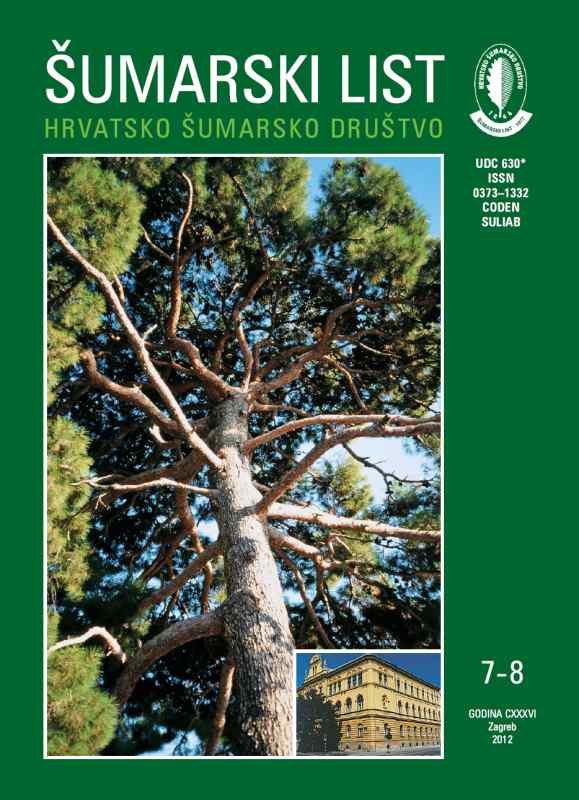
broj: 7-8/2012
pdf (5,5 MB) |
|
||||||||||||||
| RIJEČ UREDNIŠTVA | ||
| Uredništvo | ||
| SOMETHING ABOUT RESTRUCTURING pdf HR EN | 329 | |
| IZVORNI ZNANSTVENI ČLANCI | ||
| Krunoslav Teslak, Jura Čavlović, Mario Božić | UDK 630*624+653 (Pedunculate oak) (001) | |
| The even-aged forest development computer program SIMPLAG: design, structure and application pdf HR EN | 331 | |
| Milan Pernek, Sanja Novak Agbaba, Nikola Lacković, Nikolina Đođ, Ivan Lukić, Stefan Wirth | UDK 630* 165 (001) | |
| The role of biotic factors on pine (Pinus spp.) decline in north Dalmatia pdf HR EN | 343 | |
| Damir Drvodelić, Milan Oršanić, Zoran Zeman | UDK 630*233+232.3 (Pyrus pyraster Burgsd.) (001) | |
| Field performance after reforestation with one year old non-transplanted (1+0) and transplanted (1+1) seedlings of wild pear (Pyrus pyraster Burgsd.) pdf HR EN | 355 | |
| SUMMARY The paper presents the results of a three-year research into reforestation with one-year-old non-transplanted (1+0) and transplanted (1+1) seedlings of wild pear. The experiments were set on a clear field of section 5b G.J. Dubrava Mokrice managed by the Faculty of Forestry, the University of Zagreb. The soil is pseudogleic and the altitude ranges from 125 to 130 m above sea level. The research focused on field survival, height growth, increment, numbers of primary branches and seedling viability. The transplanted seedlings showed a much better survival rate compared to the non-transplanted ones. Better survival of transplanted seedlings increases with the number of growing seasons on the field, i.e. with the age of seedlings (9.9 % 10.9 %, 12.3 %). The rate of terminal shoot dying was by 1.57% higher with non-transplanted seedlings. After three seasons the non-transplanted seedlings had an average height of 762 mm (360–1640 mm) whereas for the transplanted ones it was 1142 mm (520–2050 mm). The average root collar diameter of non-transplanted seedlings was 12.15 mm (5.71–22.80) and of the transplanted ones 15.36 mm (6.49–26.29). Statistically significant differences in seedling heights were established with respect to treatment, measurement dates and dates of treatment, and in root collar diameter with respect to treatment and measurement dates. The transplanted seedlings were on average by 392 mm higher and had a 3.28 mm larger root collar diameter compared to the non-transplanted ones, which are statistically significant differences. A statistically significant difference in heights and root collar diameter between non-transplanted and transplanted seedlings was established for all measurement dates. At the end of the fourth field season the transplanted seedlings had a larger number of primary branches compared to the non-transplanted ones while the average viability remained similar. Both non-transplanted and transplanted seedlings can be used for reforestation. However, for economical purposes of nursery production and reforestation, the use of higher and older seedlings should be limited only to the areas with poor field survival. Key words: wild pear; reforestation; seedlings; transplanted plants; survival; height growth; increment | ||
| Dinka Matošević, George Melika | UDK 630*442 (001) | |
| Diversity of parasitoid assemblages of native and alien leaf miners in Croatia pdf HR EN | 367 | |
| STRUČNI ČLANCI | ||
| Marija Nodilo | UDK 630*165+907 | |
| Natural heritage of the island of Mljet – the basis of the development of the medical tourism pdf HR EN | 377 | |


